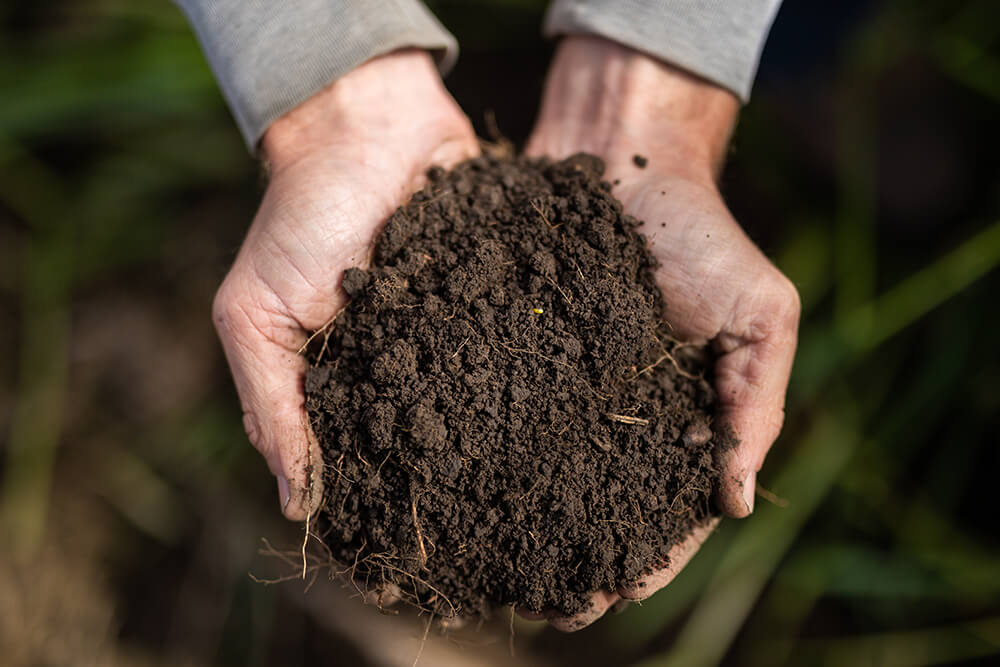The Fundamental Principles of Regenerative Agriculture and Soil Health
There is no step-by-step process to regenerative agriculture, but there are a few fundamental principles to follow.
Regenerative agriculture is not a prescription. There are no set rules or formulas for you to follow. Instead, regenerative agriculture depends on individual farmers and ranchers applying principles to their specific operations.
These principles help you make management decisions that work with the natural processes taking place in the ecosystem.
Below, we outline the fundamental principles and concepts that all regenerative farmers and ranchers should understand and follow. These principles are applicable no matter where you live or how much land you operate.

Soil Health Principles
The soil health principles are key to guiding you in building up your soil health. Always remember, the soil needs actively growing plants, vibrant communities of microbial species, and well-managed animal grazing.
Learn more about the Soil Health Principles »
Know your context.
Know your individual situation, including your climate, geography, resources, skills, family dynamics and goals. You need to understand how the ecosystem processes function on your land so that you can work with those processes. What works for someone else may not work for you because your context is different. Find what works for you, but recognize your context is always changing. Be willing to learn, grow and adapt with it.
Cover the soil.
Soil health cannot be built if the soil is uncovered or is moving. Using a diversity of plants and leaving the proper amount of forage residue minimizes bare ground and builds soil organic matter. Plant cover further protects the soil from erosion and serves as a barrier between the sun and the raw soil, preventing escalated soil temperatures that can decrease soil microbial life.
Minimize soil disturbance.
Mechanical soil disturbance, such as tillage, alters the structure of the soil and limits biological activity. If the goal is to build healthy, functional soil systems, tillage should be limited and only used in specific circumstances. Tillage of any specific acre even once each year is too much tillage. However, tillage is not the only disturbance. Grazing, fire, fertilizer and pesticide applications, etc., all can be soil disturbances. For this reason with grazing lands, one must ensure that the timing, frequency, intensity and duration of these management activities are implemented in a planned manner that aid in rebuilding ecosystem processes. Always ask yourself, “Are there any other options besides these disturbances?”
Increase diversity.
Increasing plant diversity creates an enabling environment and catalyst for a diverse underground community. In nature, grasses, legumes, forbs and woody species all work together in a native, diverse rangeland setting. The complex interactions of roots and other living organisms within the soil impact soil dynamic properties, affect carbon sequestration and enable nutrient availability for plant productivity. Managing for increased diversity can also be applied to grazing animals, wildlife, and other organisms above and below the soil.
Maintain continuous living plants/roots.
Maintaining actively growing living plant roots is encouraged to keep the soil biology processes working, no matter the season. Perennials are a big help in this, as even when dormant their roots are living and functioning (though slower compared to during the growing season). Soil microbes use active carbon first, which comes from living roots. These roots provide food for beneficial microbes and spark beneficial relationships between these microbes and the plant. Greater plant species diversity allows for living roots during an extended period of the year.
Integrate livestock.
Research, practical application and common sense tell us the same thing: livestock are a necessity for healthy soils and ecosystems. The Great Plains evolved under the presence of animals and grazing pressure. Soil and plant health is improved by proper adaptive grazing of one or more animal species, which recycles nutrients, reduces plant selectivity and increases plant diversity. As with any management practice, grazing is a tool that requires intentional application.

Indicators of Soil Health
You can go out to the pasture and dig up some soil with a shovel to get an idea of your soil’s health. As you start applying the soil health principles, notice how these indicators of soil health change over time.
Learn more about the Soil Health Indicators »
Cover
Soil cover can be evaluated in many ways, but the simplest is to look straight down at the soil surface and see if it is covered or bare. Soil could be covered in some important ways. The best way is by green plants. However, the surface could also be covered with dormant or dead plants, plant residue, manure or even rock. As soils get healthier, more of the surface will be covered with green, growing plants.
Color
Notice how dark the soil is. Generally speaking, the darker soil, the higher the organic matter and carbon content. Soil is typically darkest in the uppermost layers of the soil profile, and it lightens as depth increases. Soil organic matter and soil organic carbon are primary drivers in biologically active soil systems.
Biological Activity
Healthy soil is alive, meaning it’s biologically active and teeming with microorganisms and macroorganisms. We cannot see the microbes with the naked eye, but we can look for earthworms, earthworm castings, dung beetles, and evidence of other living creatures and their activity. Earthworms create burrows in the soil, which enables water to move down deeper into the soil. These burrows also create channels for roots to grow into. Earthworms and other insects, as well as soil microbes, play important roles in nutrient cycling.
Soil Structure
Soil structure is the arrangement of soil particles in different shapes and sizes, called aggregates. Soil aggregates are created when biotic glues hold these soil particles together. The microbes that create these glues must thrive in order to continuously replace the biotic glues, or the soil aggregates will collapse. Look for soil aggregation that has increased pore space; the more pore space, the more water can infiltrate. You want to see soil sticking to the roots even when you shake the plant. You also want to see a soil texture similar to cottage cheese or chocolate cake. The soil should crumble easily and not simply turn to dust. When it gets wet, it should retain some of that crumble and not get so watered down that it would easily wash away.
Rooting Resistance
You don’t want to see a lot of layers of compaction, or plow pans, in the soil. These restrictive layers limit root penetration and water infiltration. Another sign of this issue is seeing “J” rooting, which happens when a root starts growing at a 90-degree angle after hitting one of these restrictive layers. This situation can cause forage growth limitations, especially during drought.
Smell
Healthy soil smells fresh and earthy, thanks to an organic compound called geosmin. Geosmin is produced by active soil actinobacteria. The smell of unhealthy soil has been described by some as like hot copper pennies. Soil that smells like rotten eggs lacks oxygen and may be a sign of poor drainage.
Erosion
It doesn’t matter how healthy the soil is if it erodes away. Likewise, it is impossible to build healthy soil while it is eroding away. Signs of wind erosion can often be seen by looking for scouring with deposition behind plants and rocks. Signs of water erosion can be seen by looking for soil and litter movement which will look like little dams across the path water has traveled downhill. Signs of erosion can also be seen when there is pedestaling around and under plants and rocks.

Ecosystem Processes
Ecosystem processes are the foundation upon which all the other regenerative principles and concepts are built.
Ecological principles recognize that all ecosystems (including your ranch) function through four interconnected processes. These are nature’s ways of operating, which means that regenerative ranchers seek to understand and work within these processes as part of their operations.
Learn more about the Ecosystem Processes »
Energy Flow
It all begins with the sun. Plant leaves are the solar panels that drive the energy flow, commonly referred to the energy cycle. A plant uses this energy to turn carbon dioxide into food for itself and soil microbes, which in turn becomes forage for grazing animals and ultimately protein for humans. To ensure this process functions optimally, we need to ensure plants are always present and are given adequate time to recover from grazing.
Learn more about the energy flow »
Water Cycle
The amount of water on Earth is finite, and it cycles through evaporation, precipitation, infiltration (or runoff) and transpiration. One of the ways water moves through the cycle is through its ability to permeate the soil. The amount of water that ranchers can capture on their land can be impacted by their grazing management practices. We want to make sure the ground is covered with plant life and that soil microbes are available to form soil aggregates — which help turn the soil into a sponge that soaks up air and water.
Learn more about the water cycle »
Nutrient Cycle
In this cycle, nutrients are transferred between living organisms and the nonliving parts of the environment. Frequent disturbances, such as grazing, help maintain the aboveground nutrient cycle. Biotic activity, such as earthworms, insects and microbes in the soil, further improve the nutrient cycle. An optimal nutrient cycle depends on good plant diversity and soil cover.
Learn more about the nutrient cycle »
Community Dynamics
Community dynamics are the changes to community structure and composition over time, including changes in microbiology, plant and animal life. Plant community management is critical to the other three cycles. Having a year-round, diverse plant community can improve the nutrient cycle and optimize the energy cycle. Managing for a wide diversity of plants — forage types (grasses, forbs and trees), perennials and annuals, and cool-season and warm-season species — works to complement the other three cycles.
Learn more about community dynamics »

Rules of Adaptive Stewardship
Regenerative ranchers are adaptable and make decisions based on the circumstances at hand. They operate with an understanding of:
Compounding
Everything you do — every decision you make and practice you apply — has more than just a singular affect. Everything on the ranch affects every other part of the ranch, from the water quality to the forages to the animal health to the economics. Decisions cannot be made in isolation because all things are connected and have ripple effects that may last for years — positive or negative.
Diversity
Some may like the look of a nice clean monoculture, but nature likes diversity. You can think about it in terms of how a community is stronger when it has individuals with different skill sets. We can’t all be doctors or teachers. Some of us need to be plumbers and firefighters. It’s the same in nature. The soil needs lots of different fungi and bacteria, each of which may be attracted by a different kind of plant. Different animals also serve different functions, which, when you add up everything, creates a healthier ecosystem.
Disruption
One of the soil health principles is to minimize soil disturbance, especially minimizing or eliminating tillage, if possible. However, nature, more generally, likes a few disruptions. The key to these disruptions is being intentional with how and why you’re introducing them in order to build greater resilience in the land. They need to be planned, purposeful disruptions. Some examples of intentional disruptions might be to mix up your cover crop mix or the order in which you graze your animals, if you raise multiple classes and/or species of livestock, like cattle, sheep, goats and chickens. You could alter stock density, rotation patterns, time of season or year grazing a particular pasture, prescribed fire, paddock configuration, and rest periods. You can’t do the same thing over and over and expect to find the most success. Avoid routines in management practices. Remember, regenerative agriculture is not a prescription.
The above concepts are based on teachings from Understanding Ag, with the addition of the soil health indicators.



Comment